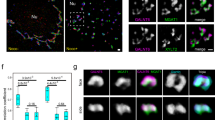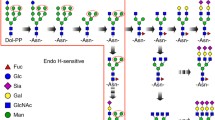Abstract
The organization of Golgi-resident proteins is crucial for sorting molecules within the secretory pathway and regulating posttranslational modifications. However, evaluating changes to Golgi organization can be challenging, often requiring extensive experimental investigations. Here, we propose a systems biology approach in which changes to Golgi-resident protein sorting and localization can be deduced using cellular N-glycan profiles as the only experimental input.
The approach detailed here utilizes the influence of Golgi organization on N-glycan biosynthesis to investigate the mechanisms involved in establishing and maintaining Golgi organization. While N-glycosylation is carried out in a non-template-driven manner, the distribution of N-glycan biosynthetic enzymes within the Golgi ensures this process is not completely random. Therefore, changes to N-glycan profiles provide clues into how altered cell phenotypes affect the sorting and localization of Golgi-resident proteins. Here, we generate a stochastic simulation of N-glycan biosynthesis to produce a simulated glycan profile similar to that obtained experimentally and then combine this with Bayesian fitting to enable inference of changes in enzyme amounts and localizations. Alterations to Golgi organization are evaluated by calculating how the fitted enzyme parameters shift when moving from simulating the glycan profile of one cellular state (e.g., a wild type) to an altered cellular state (e.g., a mutant). Our approach illustrates how an iterative combination of mathematical systems biology and minimal experimental cell biology can be utilized to maximally integrate biological knowledge to gain insightful knowledge of the underlying mechanisms in a manner inaccessible to either alone.
Access this chapter
Tax calculation will be finalised at checkout
Purchases are for personal use only
Similar content being viewed by others
References
Klumperman J (2011) Architecture of the mammalian Golgi. Cold Spring Harb Perspect Biol 3:a005181. https://doi.org/10.1101/CSHPERSPECT.A005181
Füllekrug J, Nilsson T (1998) Protein sorting in the Golgi complex. Biochim Biophys Acta, Mol Cell Res 1404:77. https://doi.org/10.1016/S0167-4889(98)00048-2
Fisher P, Ungar D (2016) Bridging the gap between glycosylation and vesicle traffic. Front Cell Dev Biol 4. https://doi.org/10.3389/FCELL.2016.00015
Zolov SN, Lupashin VV (2005) Cog3p depletion blocks vesicle-mediated Golgi retrograde trafficking in HeLa cells. J Cell Biol 168:747–759. https://doi.org/10.1083/JCB.200412003
Shestakova A, Zolov S, Lupashin V (2006) COG complex-mediated recycling of Golgi glycosyltransferases is essential for normal protein glycosylation. Traffic 7:191–204. https://doi.org/10.1111/J.1600-0854.2005.00376.X
Viinikangas T, Khosrowabadi E, Kellokumpu S (2021) N-Glycan biosynthesis: Basic principles and factors affecting its outcome. Exp Suppl 112:237–257. https://doi.org/10.1007/978-3-030-76912-3_7
Rabouille C, Hui N, Hunte F et al (1995) Map** the distribution of Golgi enzymes involved in the construction of complex oligosaccharides. J Cell Sci 108:1617–1627. https://doi.org/10.1242/JCS.108.4.1617
Ladinsky MS, Mastronarde DN, McIntosh JR et al (1999) Golgi structure in three dimensions: functional insights from the normal rat kidney cell. J Cell Biol 144:1135. https://doi.org/10.1083/JCB.144.6.1135
Dejgaard SY, Murshid A, Dee KM, Presley JF (2007) Confocal microscopy-based linescan methodologies for intra-Golgi localization of proteins. J Histochem Cytochem 55:709–719. https://doi.org/10.1369/jhc.6A7090.2007
Han HM, Bouchet-Marquis C, Huebinger J, Grabenbauer M (2013) Golgi apparatus analyzed by cryo-electron microscopy. Histochem Cell Biol 140:369. https://doi.org/10.1007/S00418-013-1136-3
Huang Y, Ma T, Lau PK et al (2019) Visualization of protein sorting at the trans-Golgi network and endosomes through super-resolution imaging. Front Cell Dev Biol 7:181. https://doi.org/10.3389/FCELL.2019.00181/BIBTEX
Fisher P, Spencer H, Thomas-Oates J et al (2019) Modeling glycan processing reveals Golgi-enzyme homeostasis upon trafficking defects and cellular differentiation. Cell Rep 27:1231–1243.e6. https://doi.org/10.1016/J.CELREP.2019.03.107
Fisher P, Thomas-Oates J, Wood AJ, Ungar D (2019) The N-glycosylation processing potential of the mammalian Golgi apparatus. Front Cell Dev Biol 7:157. https://doi.org/10.3389/FCELL.2019.00157/BIBTEX
Gillespie DT (1976) A general method for numerically simulating the stochastic time evolution of coupled chemical reactions. J Comput Phys 22:403–434. https://doi.org/10.1016/0021-9991(76)90041-3
Doob JL (1945) Markoff chains—denumerable case. Trans Am Math Soc 58:455–473. https://doi.org/10.1090/S0002-9947-1945-0013857-4
Toni T, Welch D, Strelkowa N et al (2009) Approximate Bayesian computation scheme for parameter inference and model selection in dynamical systems. J R Soc Interface 6:187–202. https://doi.org/10.1098/RSIF.2008.0172
Csilléry K, Blum MGB, Gaggiotti OE, François O (2010) Approximate Bayesian computation (ABC) in practice. Trends Ecol Evol 25:410–418. https://doi.org/10.1016/J.TREE.2010.04.001
Ha JY, Chou HT, Ungar D et al (2016) Molecular architecture of the complete COG tethering complex. Nat Struct Mol Biol 23:758–760. https://doi.org/10.1038/NSMB.3263
Ungar D, Oka T, Vasile E et al (2005) Subunit architecture of the conserved oligomeric Golgi complex. J Biol Chem 280:32729–32735. https://doi.org/10.1074/JBC.M504590200
Ungar D, Oka T, Brittle EE et al (2002) Characterization of a mammalian Golgi-localized protein complex, COG, that is required for normal Golgi morphology and function. J Cell Biol 157:405–415. https://doi.org/10.1083/JCB.200202016
Satomaa T, Heiskanen A, Mikkola M et al (2009) The N-glycome of human embryonic stem cells. BMC Cell Biol 10:1–18. https://doi.org/10.1186/1471-2121-10-42/FIGURES/6
Liu Q, Ma H, Sun X et al (2019) The regulatory ZFAS1/miR-150/ST6GAL1 crosstalk modulates sialylation of EGFR via PI3K/Akt pathway in T-cell acute lymphoblastic leukemia. J Exp Clin Cancer Res 38. https://doi.org/10.1186/s13046-019-1208-x
Abdul Rahman S, Bergström E, Watson CJ et al (2014) Filter-aided N-glycan separation (FANGS): a convenient sample preparation method for mass spectrometric N-glycan profiling. J Proteome Res 13:1167–1176. https://doi.org/10.1021/PR401043R
Ma X, Dong W, Su Z et al (2016) Functional roles of sialylation in breast cancer progression through miR-26a/26b targeting ST8SIA4. Cell Death Dis 7. https://doi.org/10.1038/CDDIS.2016.427
Lattová E, Skřičková J, Hausnerová J et al (2020) N-glycan profiling of lung adenocarcinoma in patients at different stages of disease. Mod Pathol 336(33):1146–1156. https://doi.org/10.1038/s41379-019-0441-3
Holm M, Nummela P, Heiskanen A et al (2020) N-glycomic profiling of colorectal cancer according to tumor stage and location. PLoS One 15:e0234989. https://doi.org/10.1371/JOURNAL.PONE.0234989
Dunphy WG, Rothman JE (1983) Compartmentation of asparagine-linked oligosaccharide processing in the Golgi apparatus. J Cell Biol 97:270–275. https://doi.org/10.1083/JCB.97.1.270
Bieberich E (2014) Synthesis, processing, and function of N-glycans in N-glycoproteins. 47–70. https://doi.org/10.1007/978-1-4939-1154-7_3
Bause E, Breuer W, Schweden J et al (1992) Effect of substrate structure on the activity of Man9-mannosidase from pig liver involved in N-linked oligosaccharide processing. Eur J Biochem 208:451–457. https://doi.org/10.1111/J.1432-1033.1992.TB17207.X
Chen Y, Gershlick DC, Park SY, Bonifacino JS (2017) Segregation in the Golgi complex precedes export of endolysosomal proteins in distinct transport carriers. J Cell Biol 216:4141–4151. https://doi.org/10.1083/JCB.201707172/VIDEO-9
Patterson GH, Hirschberg K, Polishchuk RS et al (2008) Transport through the Golgi apparatus by rapid partitioning within a two-phase membrane system. Cell 133:1055–1067. https://doi.org/10.1016/J.CELL.2008.04.044
Losev E, Reinke CA, Jellen J et al (2006) Golgi maturation visualized in living yeast. Nature 4417096(441):1002–1006. https://doi.org/10.1038/nature04717
Dunlop MH, Ernst AM, Schroeder LK et al (2017) Land-locked mammalian Golgi reveals cargo transport between stable cisternae. Nat Commun 81(8):1–14. https://doi.org/10.1038/s41467-017-00570-z
Marjoram P, Molitor J, Plagnol V, Tavaré S (2003) Markov chain Monte Carlo without likelihoods. Proc Natl Acad Sci 100:15324–15328. https://doi.org/10.1073/PNAS.0306899100
Wada Y, Azadi P, Costello CE, et al (2007) Comparison of the methods for profiling glycoprotein glycans--HUPO Human Disease Glycomics/Proteome Initiative multi-institutional study. Glycobiology 17:411–422. https://doi.org/10.1093/GLYCOB/CWL086
Zhang X, Vimalraj V, Patel M (2021) Routine analysis of N-Glycans using liquid chromatography coupled to routine mass detection. Methods Mol Biol 2271:205–219. https://doi.org/10.1007/978-1-0716-1241-5_15
Zhong X, Chen Z, Snovida S et al (2015) Capillary electrophoresis-electrospray ionization-mass spectrometry for quantitative analysis of Glycans labeled with multiplex carbonyl-reactive tandem mass tags. Anal Chem 87:6527–6534. https://doi.org/10.1021/ACS.ANALCHEM.5B01835
Krambeck FJ, Betenbaugh MJ (2005) A mathematical model of N-linked glycosylation. Biotechnol Bioeng 92:711–728. https://doi.org/10.1002/BIT.20645
Gelman A, Rubin DB (1992) Inference from iterative simulation using multiple sequences. 7:457–472. https://doi.org/10.1214/SS/1177011136
Author information
Authors and Affiliations
Corresponding author
Editor information
Editors and Affiliations
Rights and permissions
Copyright information
© 2023 The Author(s), under exclusive license to Springer Science+Business Media, LLC, part of Springer Nature
About this protocol
Cite this protocol
Morgan, R., West, B., Wood, A.J., Ungar, D. (2023). Modeling N-Glycosylation: A Systems Biology Approach for Evaluating Changes in the Steady-State Organization of Golgi-Resident Proteins. In: Wang, Y., Lupashin, V.V., Graham, T.R. (eds) Golgi. Methods in Molecular Biology, vol 2557. Humana, New York, NY. https://doi.org/10.1007/978-1-0716-2639-9_40
Download citation
DOI: https://doi.org/10.1007/978-1-0716-2639-9_40
Published:
Publisher Name: Humana, New York, NY
Print ISBN: 978-1-0716-2638-2
Online ISBN: 978-1-0716-2639-9
eBook Packages: Springer Protocols




